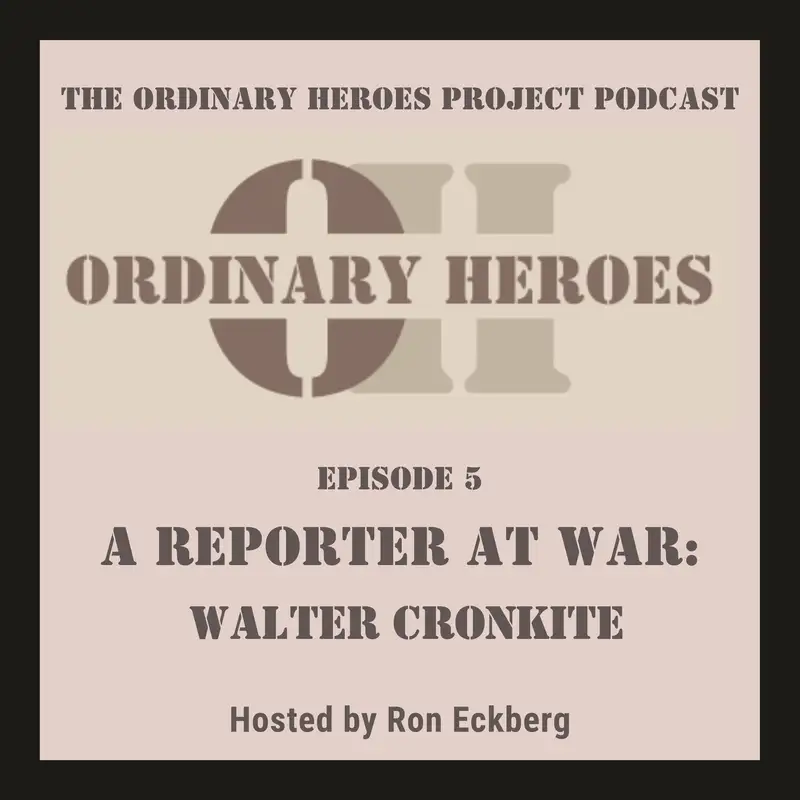A Reporter at War: Walter Cronkite
Today on the Ordinary Heroes Project Podcast we will look the story of one of the many war journalists entrusted with that duty, a man who would become one of the best, most famous, and most trusted, reporters of the 20th Century. And we will discover how World War II launched his career and how important that work was to the folks back on the Homefront.
(MUSIC)
“And that’s the way it is”. Those words were the trademark sign off of one of the 20th Century’s best journalists and best known news broadcasters; Walter Cronkite. I grew up in the 50s hearing his voice nightly on our black and white TV set. I remember the grief in his voice as he announced the death of President John F. Kennedy and the sheer childlike excitement as he covered the Apollo 11 moon landing. His warm, smooth, almost grandfatherly delivery earned him the title of America’s most trusted man. Besides, as a kid I always thought he looked a lot like Captain Kangaroo.
But Cronkite was a consummate professional, a true and honest journalism and that professionalism and honest reporting was something he honed against the backdrop of World War II.
Cronkite was born in 1916 too late for World War I but of prime age when Planet Earth became engulfed in its greatest war. Cronkite had begun his career in journalism before the war “officially” began but he could see the writing on the wall. In the late 30s, as hostilities were beginning in the Far East and in Europe, Cronkite performed a preemptive strike; sensing that the war would soon draw the United States into its fire, he enlisted in the Civilian Pilot Training Program, a program designed to provide the military with the men and women who would be needed to fly the 50,000 planes President Franklin Roosevelt would later promise to deliver each year until the war was won.
Cronkite washed out of the program, however, due to color blindness. So, Unable to fly he continued his work in journalism. As a reporter for United Press he was sent to New York to acquire credentials then set out to travel across the Atlantic with a North American ship convoy delivering essential goods to Great Britain.
Walter Cronkite set sail for war.
Cronkite then earned wings—literally—while in England attached to the Ninth Air Force, young men flying B-17 and B-24s from England to targets in Germany.
In his memoir, “A Reporter’s Life”, Cronkite describes the amazement of watching bombers come back from missions carrying wounded and dead crewman aboard and displaying battle damage that seemed impossible to survive.
One bomber’s return was remembered well by the young writer.
He watched the story unfold in front of his eyes as a plane flown by a friend came toward its landing. The plane appeared to be undamaged but as it approached it fired a flare, the signal that there was at least one wounded crewman aboard. An ambulance raced toward the end of the runway to gather up the wounded. An opened followed to ferry the crew back to the interrogation hut for debriefing.
Cronkite watched the crew arrive and initially it appeared to him that all were accounted for. Then he realized there were only nine men in the truck. A B-17 carried a crew of 10. He eventually heard the story. A single bullet had traveled through the windshield and pierced the heart of the plane’s captain, one of the most popular men in the 303rd Heavy Bombardment Group.
The remaining crew climbed from the truck, every single one weeping for their dead pilot. Cronkite admitted that he, too, wept.
“With a heavy heart, I wrote the story”, Cronkite would recall, “I called it ‘Nine Crying Boys and a Flying Fort”.
Cronkite quickly came to understand the human aspect of war, that it was about young men—and women—spilling their blood and sacrificing their lives for the cause of freedom.
Eventually, correspondents were allowed to fly missions aboard the bombers. They were first trained to handle the 50 Caliber machine guns the heavy bombers carried and upon the satisfactory completion of their training given a berth aboard planes sent out on bombing missions. The army thought of their presence as a dual purpose; they could not only capture first hand the horrors of war but could also step in to take the place of a wounded gunner.
Cronkite wanted desperately wanted that assignment. And he would get it.
“We considered ourselves a pretty exalted group”, Cronkite would remember, “An Air Force public relations man dubbed us the ‘Writing Sixty-Ninth”. Among Cronkite’s fellow flying journalists was a guy named Andy Rooney who, late in his career, would make his mark as an opinion writer for 60 Minutes.
One of Cronkite’s earliest missions taught him the ugly truth about what those young men in the heavy bombers were facing.
Their target was the German submarine pens at Wilhemshaven, one of the most heavily defended possessions of the Third Reich. The U-boats sent out of those pens were sending thousands of pounds of Allied shipping to the bottom of the Atlantic each month.
In those early days, the Allies had no planes that could fly far enough to protect the bombers all the way to the target so as soon as they would have to turn back, the German fighters would rise to strike the 17s and 24s at will.
Then came the flak, “So think you could get out and walk on it”, Cronkite remembered. Losses were heavy in both planes and men. Nearly 20% did not return.
Upon returning to London, a superior asked him what he was going to write about. Cronkite replied, “I think I’m going to say that I’ve just returned from and assignment to hell, a hell at 17,000 feet, a hell of bursting flak and screaming fighter planes, of burning Forts and hurtling bombs.”
The story resonated with readers for its honesty and insight into the reality of war.
Cronkite continued to write and folks in Europe and at home continued to read.
He would go on to cover D-Day, then the infamous failed campaign code-named Operation Market-Garden in September 1944. A combined Air and Land assault Cronkite knew he was going in with the “airborne” part of the mission and assumed that meant he would be with the paratroopers.
On the eve of the mission he was shocked to learn that, yes, he was going airborne. Just not with the paratroopers. In a glider. An American made contraption called a Waco Glider. The Waco’s skeleton consisted of a maze of aluminum tubing covered by a skin of canvas. It provided absolutely no protection against enemy fire and even less protect against elements on the ground such as trees, hedgerows, or “Hitler’s Asparagus”, telephone poles implanted in the ground that would rip apart any glider unfortunate enough to tangle with one.
It was rough from start to finish.
“I don’t recommend gliders as a way to go to war,” Cronkite wrote, “If you have to go, march, swim, crawl—anything, but don’t go by glider”.
Cronkite survived Market Garden, a brush with the Battle of the Bulge in Bastogne, being attached to General Patton’s division, and then liberation and the Nuremberg Trials.
Cronkite and others like him may not have been fighters but their contribution to the war effort was invaluable. They brought the war home from thousands of mile away.
The folks back home hung on his every word as he delivered riveting accounts of the their boys were doing, how they were fighting, and how they were dying.
(MUSIC)
(CLOSE)
Again, thank you for listening to Episode five of the Ordinary Heroes Project, and the story of one of America’s greatest war correspondants. I hope you’ve enjoyed it at least half as much as I enjoyed bringing it to you and I hope you will be looking forward to the next episode of the Ordinary Heroes Project Podcast.
It is truly my pleasure and privilege to share with you and if you haven’t already listened to them, I invite you to go back and listen to episodes 1-4.
Again, Please subscribe, like, comment or drop me a message at “ordinaryheroes@roneckberg.com” or visit my website www.roneckberg.com/heroes. Your support means so much.
I’ll look forward to meeting up with you again on the next episode of the Ordinary Heroes Project Podcast.

